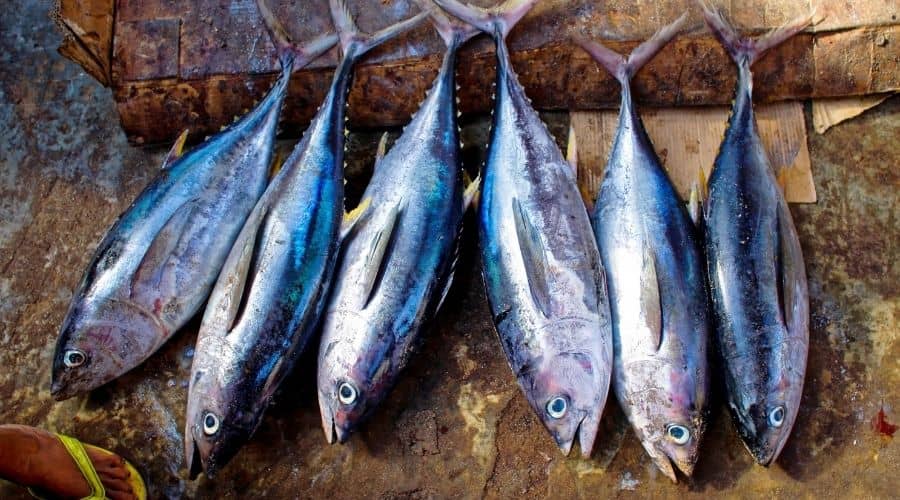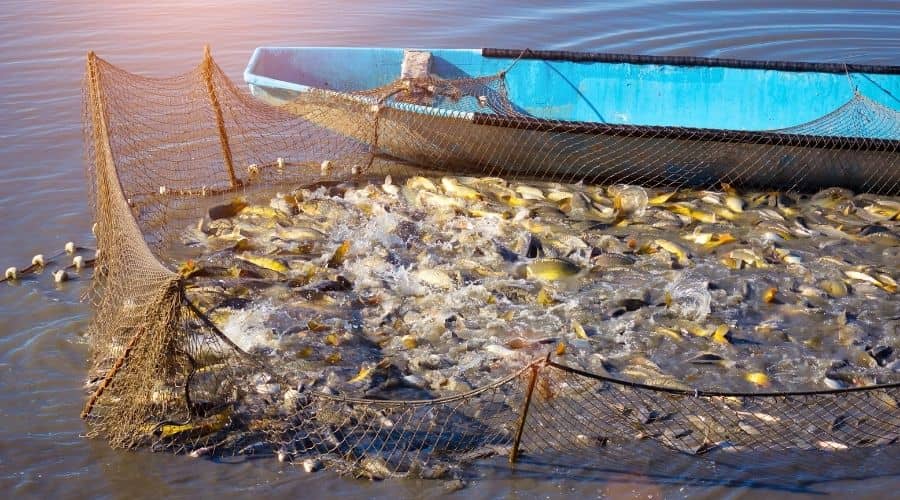
Overfishing facts show that this practice of catching more fish than the population can replenish naturally makes up one of the greatest threats to the future of our oceans.
Overfishing not only threatens fish and aquatic species with extinction, but it also can push the oceanic ecosystem to collapse.
Learn more about this threat to the natural world with these 14 statistics of overfishing.
11 Overfishing Facts Everyone Must Know
1. 90% of ocean apex predators have been wiped out
In the last 55 years, humans have managed to wipe out 90% of the ocean’s top predators. Ocean apex predators include sharks, bluefin tuna, swordfish, marlin, and king mackerel. When predators are depleted, there’s a shift in entire oceans ecosystems where smaller, plankton-feeding fish replace commercially valuable fish.
2. Fishing disrupts the marine food chain
Once the apex predators and large fish like bluefin tuna are depleted, fishers start targeting typically smaller species and fishing in different ocean locations.
3. About 38.5 million tonnes of bycatch result from overfishing annually
Bycatch is where unwanted sea animals are captured during fishing for a particular species and discarded as waste. Overfishing facts indicated that about 38.5 tonnes of bycatch result from overfishing every year.
4. About 26 million tonnes of fish are harvested illegally
Illegal and unregulated fishing represents 12-28% of fishing worldwide. This is around 11-26 million tonnes of fish.

5. China is the largest fish producer and exporter
According to overfishing statistics, China is the world’s largest fish producer and exporter, while the EU is the world’s largest importer of fish and fish products.
6. Overfishing affects 59.5 million people economically
About 59.5 million people work in the primary sector of fisheries and aquaculture. The depletion of fish stocks means these people cannot earn enough to support themselves.
7. Overfishing subsidies total an estimated $16 billion annually
Large-scale fishing companies receive an estimated $16 billion in subsidies every year. These subsidies indirectly encourage fuel-intensive fishing and destructive fishing practices such as deep-sea trawling.
8. Demand for fish has gone up by 527% in the last decade
Aquaculture production has experienced a growth rate of 527% from 1990 to 2018, thanks to increased demand for fish. Fish consumption has risen by 122% in the same time frame.
9. About 55% of the world’s oceans have been taken over by industrial fishing
Facts about overfishing show that industrial fishing is a widespread practice, occurring in more than 55% of all ocean areas.
10. There will be an approximate 3–25% decrease in global fish biomass by the end of this century
Overfishing stats from the United Nations indicate that the practice has led to approximately a 25% decrease in the extent of seagrass meadows.
11. Norway, Japan, and Iceland kill over 100,000 small whales a year
On a yearly average, Norway, Japan, and Iceland hunt over 1,500 large whales, and over 100,000 small whales, dolphins, and porpoises.
3 Interesting Overfishing Statistics
1. Anchoveta is the most popular fish to be caught, with 7 million tons in 2018
Overfishing data shows that anchoveta is the most popular fish species, followed by the Alaska pollock and the Skipjack tuna.
2. The amount of fish eaten by consumers in a year has doubled
The average person consumes about 19.2kg of fish a year. This amount has doubled in the last 50 years.
3. Industrial fishing vessels record around 400 million hours of work per year
According to statistics on overfishing collected during a 2016 study, industrial fishing vessels recorded 40 million working hours, consuming 19 billion KWh of energy, and traveling a combined distance of around 460 million kilometers. This distance is enough to go to the moon and back 600 times.
Why Is Overfishing a Problem?
The problem with overfishing is that it endangers ocean ecosystems and has put a third of the world’s assessed fisheries at risk. Overfishing also affects billions of people who rely on seafood as either a source of income or food.
How Many Fish Are Being Overfished?
An estimated 34% of the world’s fish stocks suffer from overfishing today.
Where Is Overfishing Happening?
Most of the overfishing in the world happens in the Mediterranean and the Black Sea, where fish stocks suffer from an estimated 62% overfishing. An estimated 59% of fish stocks are overfished in the Atlantic Ocean.
These overfishing facts paint an accurate picture of the effects of the practice. They reveal that we must urgently find ways to deal with overfishing and support sustainable aquaculture. Other solutions for overfishing include buying sustainably certified seafood and ensuring that you only buy fish caught sustainably.
You Might Also Like:

![]() Jamie - Cofounder
Jamie - Cofounder
Hi, I hope you enjoyed reading this article.
If you are looking for more ways to live an eco-conscious lifestyles, then check out our complete guide here.
Thanks for stopping by - Jamie


